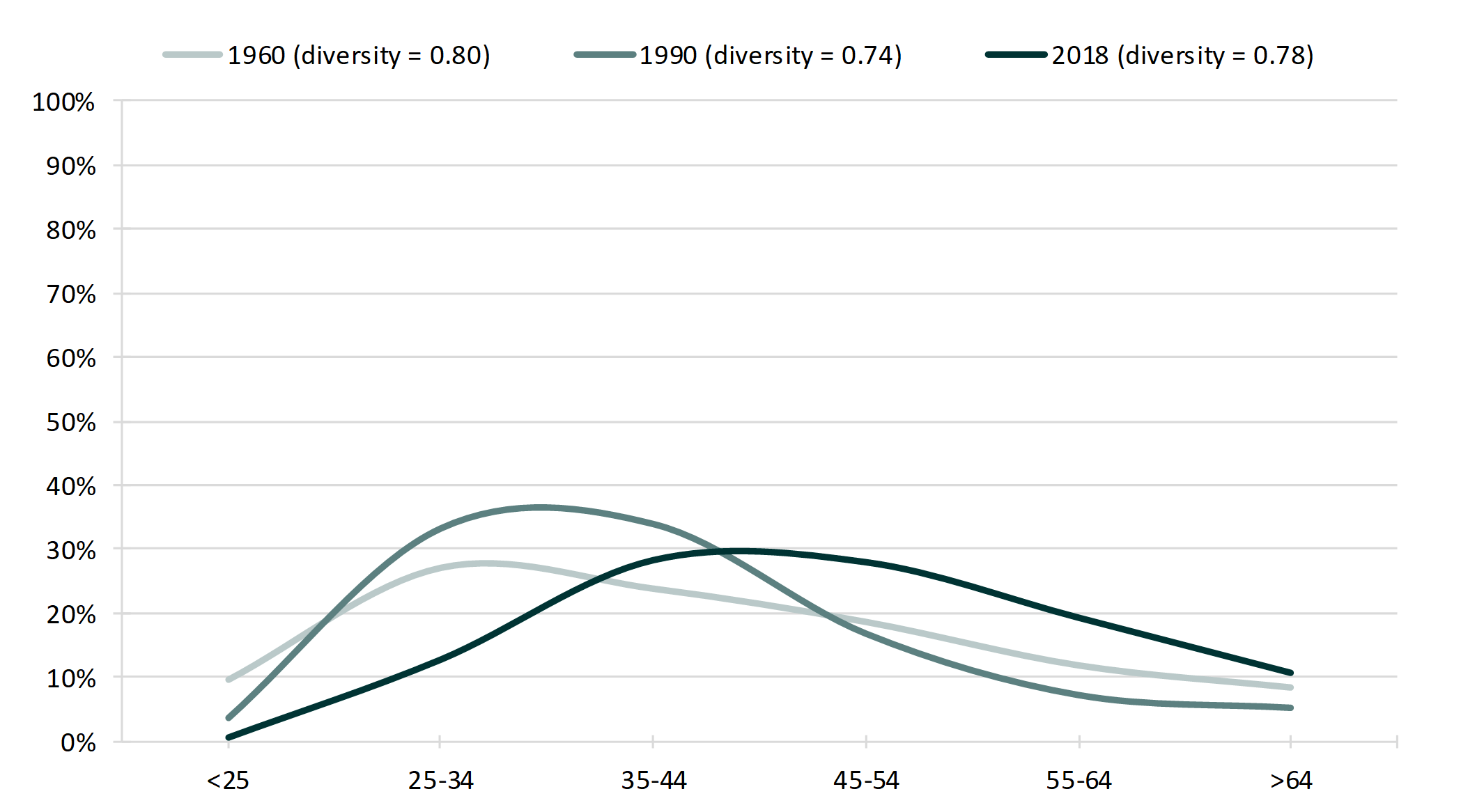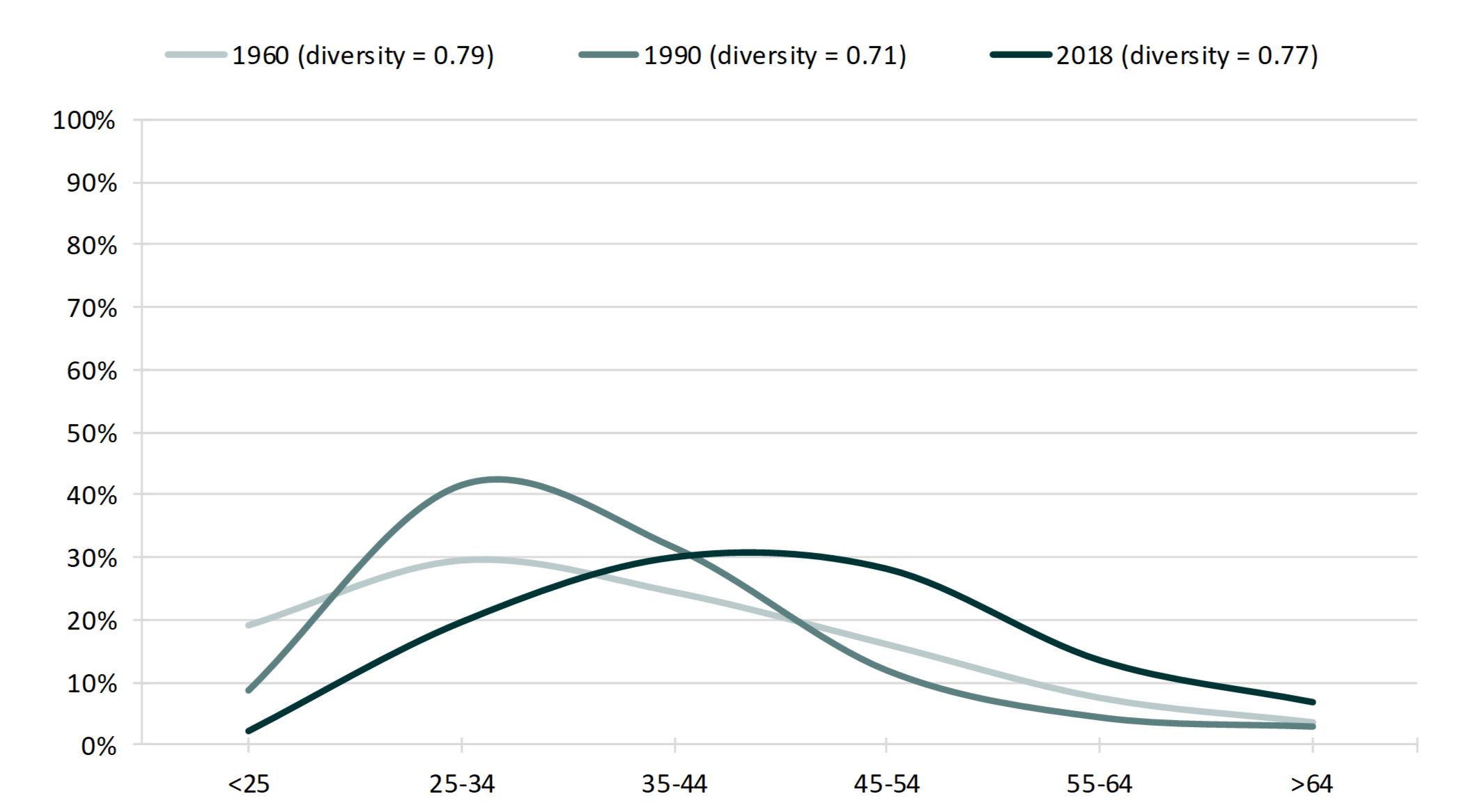Distributions of Age at Remarriage, 1960-2018
Family Profile No. 10, 2020
Author: Paul Hemez
Recent estimates indicate the remarriage rate has declined in the past several decades, suggesting fewer previously married men and women enter a new marriage today compared with those who were previously married forty years ago (Schweizer, 2019; Smock & Schwartz, 2020). During the same period, the ages at which men and women remarry increased. Between 1950 and 2017, the median age at remarriage rose from 40 for men and 34 for women, to 46 and 43 for men and women, respectively (Schweizer, 2019). This Family Profile extends research on demographic changes in remarriage by considering how the age distributions of men and women who remarried have shifted from 1960 to 2018. Estimates are produced using 1960 and 1990 vital statistics data from marriage certificates and the 2018 American Community Survey. This profile builds on work by Cohen (2013), and all analyses are limited to states that were in Marriage Registration Areas in 1960. We use the diversity index, to measure variation in the distributions of a population’s age at remarriage, with higher scores representing more diverse experiences (i.e., a wider age range among remarriages). This family profile is part of a series on the age distributions of family formation experiences, with companion profiles exploring how the ages at first marriage and parenthood have shifted.
Men’s Age at Remarriage Distributions
The diversity index indicates men’s ages at remarriage became less varied between 1960 and 1990 but have since become more diverse.
- The share of men who were younger than 25 when they remarried declined in recent decades, from about 10% in 1960 to less than 1% in 2018.
- Half (51%) of the men who experienced a remarriage in 1960 did so between the ages of 25 and 44. In 1990, the share had increased to two-thirds (67%) but fell to about 40% by 2018.
- Reflecting trends in the median age at remarriage, the percentage of men who remarried in their mid-50s or later had grown from 21% in 1960 to 30% in 2018.
Figure 1. Men’s Distributions of Age at Remarriage

Women’s Age at Remarriage Distributions
The diversity of women’s ages at remarriage follows a similar pattern to the ages of men’s remarriage. Between 1960 and 1990, women’s ages at remarriage became less diverse, but by 2018, women’s ages at remarriage became more diverse.
- About 19% of women who remarried in 1960 were younger than 25. This share declined to about 9% of those who remarried in 1990 and 2% of those who remarried in 2018.
- In 1960 and 1990, remarriage occurred most often to women between the ages of 25 and 34. In 2018, however, women most often reported being between the ages of 35 and 44 when they remarried.
- Among women who remarried, the share who did so at the age of 55 or older nearly doubled from about 11% in 1960 to 20% in 2018.
Figure 2. Women’s Distributions of Age at Remarriage


References
- Cohen, P. N. (2013). Data visualization: Is U.S. society becoming more diverse? Family Inequality. https://familyinequality.wordpress.com/2013/02/17/data-visualizations-is-u-s-society-becoming-more-diverse/
- Schweizer, V. (2019). The retreat from remarriage, 1950-2017. Family Profiles, FP-19-17. Bowling Green, OH: National Center for Family & Marriage Research. https://doi.org/10.25035/ncfmr/fp-19-17
- Smock, P. J., & Schwartz, C. R. (2020). The demography of families: A review of patterns and change. Journal of Marriage and Family, 82(1), 9-34.
Suggested Citation
- Hemez, P. (2020). Distributions of age at remarriage, 1960-2018. Family Profiles, FP-20-10. Bowling Green, OH: National Center for Family & Marriage Research. https://doi.org/10.25035/ncfmr/fp-20-10

This project is supported with assistance from Bowling Green State University. From 2007 to 2013, support was also provided by the U.S. Department of Health and Human Services, Office of the Assistant Secretary for Planning and Evaluation. The opinions and conclusions expressed herein are solely those of the author(s) and should not be construed as representing the opinions or policy of any agency of the state or federal government.
Updated: 04/06/2021 02:08PM


